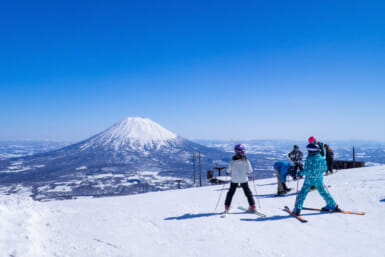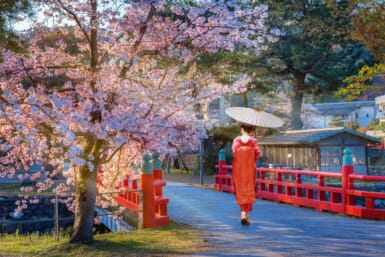Take a tour through Akita’s red hues, from the crimson flash of a Shinkansen to the masks of the Namahage.
By Robert Morel
As the air turns chill and the days slowly get shorter, the green tones of Akita summer give way the blaze of red-orange-yellow autumn leaves, the warm fires of home, and torches carried down from the mountains by crimson-faced namahage. It is the time to dig in to local foods cooked over the orange flames of an irori hearth, a time to appreciate the bright color and smooth flavors of prize-winning local beef. A time when early sunsets make a dramatic backdrop to the mountains, casting the sight in warm waves of color. Red is a primal color of Akita, one that comes out most in the colder months. It comes out in festival lanterns and bright masks, sunsets and winter fires. Even the new Akita Super Komachi Shinkansen’s red and white color scheme reflects the importance of this color to the region. While there are many ways to experience the reds of Akita, here are a few of the best ones.
Super Komachi
Debuting in March 2013, the Super Komachi is not only Japan’s newest and fastest Shinkansen, but also its most stylish and comfortable. Traveling at 300 km/h, the Super Komachi winds its way through Tohoku’s scenic fields, towns, and valleys. Thanks to a state-of-the-art active suspension system, a spacious interior and ergonomic seats, the 3 hour and 45 minute ride from Tokyo to Akita City passes in a flash.
And what a stylish flash it is. While most train designs appeal only to a small group of hobbyists, the Super Komachi’s exterior is nothing if not cool. With its sleek profile, crimson front and a roof that calls to mind images of Akita’s red-faced namahage and fiery festival lanterns, the train looks more like a luxury sports car than public transit. And with design overseen by former Ferrari designer Ken Okuyama, it’s easy to see why. Combining style, comfort, and speed, the Super Komachi brings Akita closer to Tokyo than ever before.
Namahage
Every New Year’s Eve, the namahage sweep down from the mountains into the villages of Akita’s Oga Peninsula. Faces bright red, carrying drums and heavy knives they pound on doors demanding entry. But despite their frightful appearance the namahage are not demons, but guardians against sloth and disharmony.
Watching from their mountaintop perches throughout the year, they see all in the villages below. Their noisy entrance expels evil spirits, they scare unruly children into behaving, and they promise good luck to families who are getting along and working hard.
Today, young men in the towns put on the red mask and long straw cape of the namahage and go door-to-door terrorizing children into good behavior and amusing the adults. Although the namahage typically come out on New Year’s Eve, there are festivals throughout the winter, the biggest being the Nagahame Sedo Matsuri, on the second full weekend of February. Here, visitors can watch the torch-lit procession of namahage as they tramp through the snow, growling menacingly before bestowing them with good luck for the year to come. The experience is at once eerie and raucously festive. Despite the flash of cameras it feels like being carried back to a much older time when, for one night at least, the namahage ceased to be villagers in bright red masks and became true crimson-faced deities of the mountains.
Kurikoma Sansou
Nestled in the serene environs of the Kurikama Quasi-National Park at Akita’s southern tip, Kurikama Sansou is a beautiful getaway year-round. With the cool air of October, though, the mountainside is set ablaze with the fiery reds, yellows, and oranges of the changing leaves. Various evergreens act as stunning pinpoints of contrast, accentuating the bright colors cast by the oak, maple, alpine cherry, and Japanese ash trees. While the view of the mountainside from the bottom of the well-maintained trail is impressive, hiking 90 minutes to the summit and looking down on the array of colors is intoxicating. After taking in the views, it’s worth stopping to soak in an onsen at the Sukawa spa resort, overlooking the mountainside, as well as a quick rest at the Kurikama Sansou Ashi no Yu footbath.
Yoshihira Beef
Little known outside of the region, Akita’s Yoshihira Beef seemingly came out of nowhere to take second prize at Japan’s premiere beef competition, the Wagyu Olympics. The beef is beautifully marbled, with wisps of white threading through the bright red meat, and incredibly tender. To sample this local delicacy, try Ichiyoshi in the town of Yurihonjo, 40 minutes south of Akita City. Housed in an historic Edo-period building, this ryotei-style restaurant serves Yoshihira beef and excellent local fare. It is well worth the trip and the price.
Gojira Rock
Jutting out into the Sea of Japan, Akita’s axe-shaped Oga Peninsula is well known for its stunning, craggy coastline and impressive rock formations. None though, are as famous or impressive as Gojira Rock. Looking just like a petrified version of its namesake—Godzilla—Gojira Rock has to be one of Japan’s most unique natural rock formations. While the giant monster looks, well, a bit fossilized during the day, at dusk it comes to life, a black silhouette against the red-orange sunset. The rest of Shiosezaki Cape’s rocky shore is beautiful too, making this a good stop along the Oga Peninsula’s coastline.
Getting there
The best way to get to Akita is the Akita Shinkansen from Tokyo or Ueno station. Check with the JR counter to be sure to get a seat on one of the new E6 Super Komachi trains. For Gojira Rock and the Namahage Sedo Matsuri, take the JR Oga line from Akita Station to Oga Station. From there take the Akita Chuoukoutsu bus: OGA-south line to Hokakejima bus stop (30 minutes, ¥590) and walk to the coast. Buses from Oga Station to the Sedo Matsuri run regularly throughout the festival. The best way to reach Kurikoma Sansou is by airport bus: Kurikoma line (2 hours 30 minutes, ¥10,000). Alternatively, from Ichinoseki Station take the Iwate Kotsu bus: Sukawa onsen line (1 hour, 30 minutes, ¥1,450).









